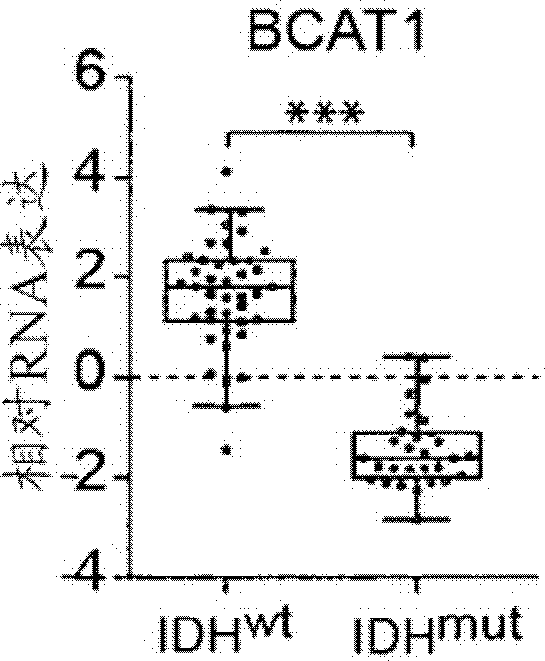Inhibitors of branched-chain-aminotransferase-1 (BCAT1) for the treatment of brain tumors
A branched chain amino, brain tumor technology, applied in the field of compounds in one method, capable of solving problems ranging from months to 16 months
- Summary
- Abstract
- Description
- Claims
- Application Information
AI Technical Summary
Problems solved by technology
Method used
Image
Examples
Embodiment 1
[0081] general method
[0082] (a) RNA isolation and quantitative real-time polymerase chain reaction (qRT-PCR)
[0083] Total RNA was extracted using the AllPrep DNA / RNA / Protein Mini Kit (Qiagen) according to the manufacturer's instructions. from Ambion The human brain was referenced to total RNA as a pool of normal brain RNA molecules (n=23 donors). Total RNA (500 ng) was reverse transcribed using random primers and superscript II (reverse transcriptase) (Invitrogen, Karlsruhe, Germany) according to the manufacturer's instructions. Each complementary protein was analyzed in triplicate using the Applied Biosystems Prism7900HT Fast Real-Time PCR System (Applied Biosystems, Foster City, CA, USA) with Absolute SYBR Green ROX Mix (ABgene, Epsom, UK). DNA samples. Relative amounts of specific mRNAs were normalized to ARF, B2M and TBP. Primer sequences are given in Table 1A below.
[0084] Table 1A
[0085]
[0086] (b) Western blot analysis
[0087] All experiments invo...
Embodiment 2
[0131] Inhibition of cell proliferation by gabapentin
[0132] Human glioblastoma cell lines U87-MG (HTB-14), HS683 (HTB-138) and U373-MG (HTB-17; LGC standard, Teddington TW110LY, UK) were cultured in supplemented with 10% fetal Dulbecco's minimum essential medium with bovine serum and 1% penicillin / streptomycin mixture. Seed at 5x104 cells / well in a total volume of 500 µL of cell culture medium in a 24-well plate. At 4 hours after seeding the cells, the medium was removed, and then 500 μL of 1-(aminomethyl)-cyclohexaneacetic acid (cyclohexylessigsaure) (gabapentin, dissolved at 500 mM in 200 mM HEPES buffer) for medium replacement. A corresponding volume of 200 mM HEPES was added to each control well. At 5 h after the medium exchange, 5-ethynyl-2'deoxyuridine (EdU; Carlsbad, CA92008, USA) was added to utilize Invitrogens (Carlsbad, CA92008, USA) The proliferation kit measures cell proliferation. Sixteen hours after EdU application, cells were harvested and proliferatio...
Embodiment 3
[0134] Inhibition of cell proliferation by BCAT1 antisense oligonucleotides
[0135] Lentivirus was produced by co-transfection of HEK293T cells with psPAX2 (Addgene12260, Didier Trono, packaging vector), pMD2.G (Addgene12259, Didier Trono, envelope plasmid) and pLKO.1shRNA construct (Sigma-Aldrich, St. Louis, MO63178, USA) carrier. use -LT1 (Mirus Bio LLC, Madison, WI 53711, USA) was transfected, and virus was obtained 48 hours and 72 hours after transfection. Two separate shRNA constructs targeting different regions of the BCAT1 mRNA transcript were used: MISSION shRNA TRCN0000005907NM_005504.3-1064slcl (shRNA1) and TRCN0000005909NM_005504.3-751slcl (shRNA2); both Sigma-Aldrich, St. Louis, MO63178, USA. Non-targeting shRNA was used as a control.
[0136] Human glioblastoma cell lines U87-MG (HTB-14), HS683 (HTB-138) and U373-MG (HTB-17; LGC standard, Teddington TW110LY, UK) were seeded in 24-well plates (5x10 ^4 cells / well) in a total volume of 500 μL of cell culture me...
PUM
 Login to View More
Login to View More Abstract
Description
Claims
Application Information
 Login to View More
Login to View More - R&D Engineer
- R&D Manager
- IP Professional
- Industry Leading Data Capabilities
- Powerful AI technology
- Patent DNA Extraction
Browse by: Latest US Patents, China's latest patents, Technical Efficacy Thesaurus, Application Domain, Technology Topic, Popular Technical Reports.
© 2024 PatSnap. All rights reserved.Legal|Privacy policy|Modern Slavery Act Transparency Statement|Sitemap|About US| Contact US: help@patsnap.com










